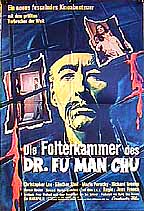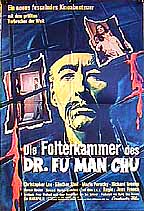Castle of Fu Manchu
Fu Manchu's Castle
Sax Rohmer's The Castle of Fu Manchu
The Torture Chamber of Fu Manchu
| Tagline(s): | HE'S BACK!!! The World's Most Evil Man with a Fiendish Plan of Conquest |
| Never Before Seen |
The film that was to be the final entry in the new Fu Manchu series from international quickie film financier Harry Alan Towers made its belated theatrical appearance four years after it was made. In the USA, it played the bottom of the bill on the drive-in theater circuits. It crept into theaters sheepishly, victim of the commercial and critical thrashing given to its predecessor. The word in fan circles was that "Castle of Fu Manchu" was a new low, even worse than what had come before. It would be years before many of these same fans were able to see the film, which rapidly disappeared into obscurity until resurrected from its public domain limbo by the home video market. This film's non-performance at the world's box offices effectively killed the series: the contracted sixth Fu manchu film was never made. On a technical level, "Castle" is a notch below even the low standards established by its predecessor. The shadows of the camera crew are visible in some scenes. Director Jess Franco's chronic zoom photography is more annoying and lazy here. Parts of the film are so technically shoddy, they barely achieve the level of the average home movie. The most professional scene in the film is a dolly shot of Maria Perschy crossing a Madrid street, and this was filmed by the second unit! However, because its script is slightly better, this film can arguably be ranked above "Blood of Fu Manchu", although few fans would risk their credibility defending either film. At least "Castle" is concerned with Fu Manchu's current plot to conquer the world and does not pad out its running time with irrelevant subplots. What it does use for padding is stock footage. For its opening sequence, "Castle" lifts the entire climax of "Brides of Fu Manchu" and, incredibly, extends this sequence with footage of the Titanic from the 1958 film "A Night to Remember"! Using stock footage to supplement stock footage is either brashly clever or establishes a new standard of cheapness. Perhaps the ultimate snub to the film came from the producer himself, who kept his wife Maria Rohm out of the cast.


